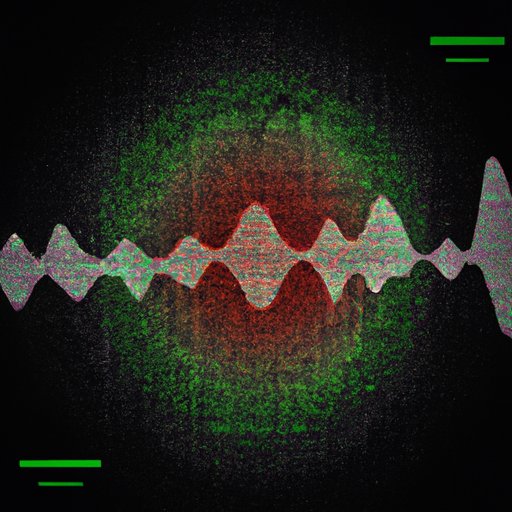Introduction
Noise canceling is a type of technology used to reduce unwanted sounds or noises in a given environment. It can be used to improve user experience in a variety of settings, such as transportation, entertainment, and work spaces. In this article, we’ll explore the science behind sound waves and take an in-depth look at how noise canceling works.

Exploring the Science Behind Noise Canceling Technology
In order to understand how noise canceling works, it’s important to first have a basic understanding of the physics behind sound waves. Sound waves are created when objects vibrate, sending out pressure changes through the air. These pressure changes travel through the air in the form of sound waves, which can then be detected by the human ear. The frequency of the sound waves determines the pitch of the sound, while the amplitude of the sound waves determines the loudness of the sound.
Noise canceling works by identifying and eliminating certain frequencies of sound waves. This is done by analyzing the sound waves and then creating a “mirror image” of those sound waves. This mirror image is then used to cancel out the original sound waves, resulting in a quieter environment.
An In-Depth Overview of How Noise Canceling Works
Noise canceling technology is composed of several different components that work together to create a quieter environment. The most important component of noise canceling technology is the microphone. The microphone picks up sound waves and sends them to the processor, which analyzes the sound waves and creates a “mirror image” of them. The processor then sends the “mirror image” sound waves to the speaker, which emits a sound wave that cancels out the original sound wave.
Noise canceling technology can be used in a variety of ways. For example, it can be used to block out outside noise in a home or office environment. It can also be used to reduce noise in transportation, such as airplanes or trains. Additionally, noise canceling technology can be used to enhance the listening experience for music, movies, and other audio content.
A Closer Look at the Different Components of Noise Canceling Technology
The microphone is the most important component of noise canceling technology. It is responsible for picking up sound waves and sending them to the processor. The processor then uses algorithms to analyze the sound waves and create a “mirror image” of them. The processor then sends the “mirror image” sound waves to the speaker, which emits a sound wave that cancels out the original sound wave.
There are two types of noise canceling technology: active and passive. Active noise canceling uses microphones to pick up sound waves and then creates a “mirror image” of those sound waves. This “mirror image” is then used to cancel out the original sound wave. Passive noise canceling uses materials such as foam or insulation to absorb sound waves before they reach the listener.

Examining the Benefits of Using Noise Canceling Devices
Using noise canceling devices can provide a variety of benefits. For example, they can help reduce stress and improve concentration by blocking out distracting noises. Additionally, noise canceling devices can help improve sleep quality by blocking out disruptive sounds. Finally, noise canceling devices can make listening to audio content more enjoyable by reducing background noise and enhancing the overall sound quality.

How to Choose the Right Noise Canceling Device for Your Needs
When selecting a noise canceling device, there are several factors to consider. First, you should consider the type of noise canceling technology you need. If you want to block out outside noise in a home or office environment, you may want to consider an active noise canceling device. If you want to reduce noise in transportation, you may want to consider a passive noise canceling device. Additionally, you should consider the features offered by the device, such as battery life, portability, and sound quality.
You should also compare different noise canceling devices to determine which one best meets your needs. Consider the features each device offers, as well as the price. Additionally, you should read customer reviews to get a better understanding of how the device performs in real-world situations.
Conclusion
Noise canceling technology can be used to reduce unwanted sounds or noises in a given environment. By understanding the science behind sound waves and exploring the different components of noise canceling technology, it’s possible to create a quieter environment and improve user experience. Additionally, there are several benefits to using noise canceling devices, and it’s important to consider the various factors when selecting the right device for your needs.
If you’re interested in learning more about noise canceling technology, there are plenty of resources available online. From reading articles and watching videos to talking with experts and testing out different devices, there are many ways to gain a deeper understanding of how noise canceling works.
(Note: Is this article not meeting your expectations? Do you have knowledge or insights to share? Unlock new opportunities and expand your reach by joining our authors team. Click Registration to join us and share your expertise with our readers.)
